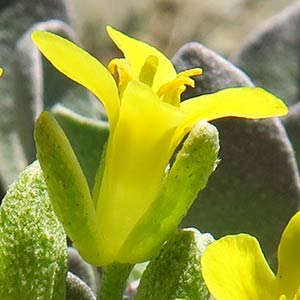|
alpine twin-pod, Washington bladder-pod, Washington twin-pod
|
Navajo bladderpod
|
| Perennials; caudex usually simple, rarely branched, (cespitose); (silvery) pubescent throughout, trichomes several-rayed, rays (1- or) 2-bifurcate, (low-umbonate, tubercles relatively few, small). |
Perennials; caudex branched, (woody, pulvinate-cespitose, forming hard, hemispherical mats, basal parts covered with persistent leaf bases); densely (silvery gray) pubescent, trichomes mostly 5-rayed, rays bifurcate, slightly fused at base, (umbonate, strongly tuberculate except nearly smooth over umbo). |
several from base, decumbent to ascending, (unbranched), 0.5–1.5 dm. |
several from base (crowded), erect, not exceeding leaves. |
(petiole slender); blade obovate, 3–5 cm (width 10–20 mm, base tapering abruptly to petiole), margins entire, (apex rarely slightly acute). |
usually absent. |
blade oblanceolate, 0.5–1.5 cm (width 3–5 mm), margins entire. |
(petiole not differentiated from blade); blade linear-oblanceolate, 3–8(–13) mm, margins entire. |
subcorymbose. |
(secund), dense, corymbose, (few-flowered, not or barely exceeding leaves). |
sepals oblong, 8–10 mm; petals spatulate, 12–14 mm. |
sepals (yellow-green), linear to narrowly triangular, 3.7–4.8 mm, (lateral pair subsaccate); petals (deep yellow, slightly orange in center), spatulate, 5.2–6.5 mm, (claw joined at right angle). |
(divaricate, straight), 5–10 mm. |
(ascending to divaricate-ascending, straight), 3.5–6 mm. |
didymous, mostly highly inflated (strongly flattened at least in 1/2 toward replum), 14–18 × 14–18 mm, (papery, basal sinus slightly notched, apical open, shallow); valves (retaining seeds after dehiscence), evenly pubescent; replum lanceolate, 7–10 mm, width 1.5–2.5 mm, as wide as or wider than fruit, apex acute to acuminate; ovules 8–10 per ovary; style 5–7 mm. |
(becoming reddish or copper-colored in age), ovate, often slightly compressed (at margins apically), 3–5 mm, (apex acute); valves (not retaining seeds after dehiscence), glabrous; (septum perforate or not); ovules 4–8 per ovary; style 1.8–3 mm. |
flattened, (2–3 mm). |
plump or slightly flattened, (strongly mucilaginous). |
= 48–52, 52, 64, 67–70. |
|
|
|
|
|
| Flowering May–Jun. |
Flowering May-early Jun. |
| Alpine scree, rocky ridges, talus slopes, volcanic sands and gravel, serpentine gravel, granitic slopes, mountain shrub, subalpine fir, and whitebark pine communities |
Pinyon-juniper communities on nearly barren outcrops of Todilto Limestone |
| (700-)1300-2400 m ((2300-)4300-7900 ft) |
2200-2400 m (7200-7900 ft) |
|
WA
|
AZ; NM |
|
Of conservation concern. Physaria navajoensis is morphologically similar to 85. P. tumulosa of southern Utah, differing subtly. Physaria navajoensis has petals slightly orange at the junction of blade and claw, a sharp bend at that junction giving the flower a flat-topped appearance, and strongly mucilaginous seeds. Physaria tumulosa has pure yellow petals that gently flex at the junction of blade and claw, and seeds that are not mucilaginous. Molecular data (pers. obs.) show that these two species are not directly related. A population of plants on Deer Spring Point, Kane County, Utah, appears to be this species, but molecular data indicate that it is probably a hybrid between P. tumulosa and, most likely, P. intermedia. (Discussion copyrighted by Flora of North America; reprinted with permission.) |
| FNA vol. 7, p. 624. |
FNA vol. 7, p. 651. |
| Brassicaceae > tribe Physarieae > Physaria |
Brassicaceae > tribe Physarieae > Physaria |
P. acutifolia, P. alpina, P. angustifolia, P. arctica, P. arenosa, P. argyraea, P. arizonica, P. aurea, P. bellii, P. brassicoides, P. calcicola, P. calderi, P. carinata, P. chambersii, P. cinerea, P. condensata, P. congesta, P. cordiformis, P. curvipes, P. densiflora, P. didymocarpa, P. dornii, P. douglasii, P. eburniflora, P. engelmannii, P. eriocarpa, P. fendleri, P. filiformis, P. floribunda, P. fremontii, P. garrettii, P. geyeri, P. globosa, P. gooddingii, P. gordonii, P. gracilis, P. grahamii, P. hemiphysaria, P. hitchcockii, P. humilis, P. integrifolia, P. intermedia, P. kingii, P. klausii, P. lata, P. lepidota, P. lesicii, P. lindheimeri, P. ludoviciana, P. macrocarpa, P. mcvaughiana, P. montana, P. multiceps, P. navajoensis, P. nelsonii, P. newberryi, P. obcordata, P. obdeltata, P. occidentalis, P. oregona, P. ovalifolia, P. pachyphylla, P. pallida, P. parviflora, P. parvula, P. pendula, P. pinetorum, P. prostrata, P. pruinosa, P. pulvinata, P. purpurea, P. pycnantha, P. rectipes, P. recurvata, P. reediana, P. rollinsii, P. saximontana, P. scrotiformis, P. sessilis, P. spatulata, P. subumbellata, P. tenella, P. thamnophila, P. tumulosa, P. valida, P. vicina, P. vitulifera |
P. acutifolia, P. alpestris, P. alpina, P. angustifolia, P. arctica, P. arenosa, P. argyraea, P. arizonica, P. aurea, P. bellii, P. brassicoides, P. calcicola, P. calderi, P. carinata, P. chambersii, P. cinerea, P. condensata, P. congesta, P. cordiformis, P. curvipes, P. densiflora, P. didymocarpa, P. dornii, P. douglasii, P. eburniflora, P. engelmannii, P. eriocarpa, P. fendleri, P. filiformis, P. floribunda, P. fremontii, P. garrettii, P. geyeri, P. globosa, P. gooddingii, P. gordonii, P. gracilis, P. grahamii, P. hemiphysaria, P. hitchcockii, P. humilis, P. integrifolia, P. intermedia, P. kingii, P. klausii, P. lata, P. lepidota, P. lesicii, P. lindheimeri, P. ludoviciana, P. macrocarpa, P. mcvaughiana, P. montana, P. multiceps, P. nelsonii, P. newberryi, P. obcordata, P. obdeltata, P. occidentalis, P. oregona, P. ovalifolia, P. pachyphylla, P. pallida, P. parviflora, P. parvula, P. pendula, P. pinetorum, P. prostrata, P. pruinosa, P. pulvinata, P. purpurea, P. pycnantha, P. rectipes, P. recurvata, P. reediana, P. rollinsii, P. saximontana, P. scrotiformis, P. sessilis, P. spatulata, P. subumbellata, P. tenella, P. thamnophila, P. tumulosa, P. valida, P. vicina, P. vitulifera |
| Lesquerella alpestris |
Lesquerella navajoensis |
| Suksdorf: W. Amer. Sci. 15: 58. (1906) |
(O’Kane) O’Kane & Al-Shehbaz: Novon 12: 325. (2002) |
| |


